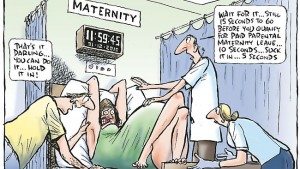Being a working mother is difficult; she has to balance her career but and her newborn baby. It seems logical to allow working mothers who just gave birth time to recuperate before coming back to work, but employers and the government seem to believe otherwise.
Introduction
In a country where there is a strong emphasis on work and making money, women are delaying having children due to the intense work culture. In  1970, the average woman had her first child at 21.4 years old; by 2012, it was about 26. Women seem to be waiting longer to have children because it has become harder to receive paid maternity leave, and in this economy, unpaid maternity leave can be detrimental to women and their families. In 2013, the Bureau of Labor Statistics stated that about 47 percent of women make up the country’s workforce and of that percentage, about 64 percent are mothers with children under the age of six.
1970, the average woman had her first child at 21.4 years old; by 2012, it was about 26. Women seem to be waiting longer to have children because it has become harder to receive paid maternity leave, and in this economy, unpaid maternity leave can be detrimental to women and their families. In 2013, the Bureau of Labor Statistics stated that about 47 percent of women make up the country’s workforce and of that percentage, about 64 percent are mothers with children under the age of six.
Because of unpaid maternity leave, women are going back to work sooner than their bodies might allow. Paid maternity leave is a necessity because taking care of a newborn and oneself is already a full-time job.
Issues that Working Mothers Encounter
The United States is one of four countries that do not mandate paid leave for new mothers. Currently, working mothers who want paid maternity leave can apply for the Family and Medical Leave Act (FMLA). This act states that eligible employees must work for a covered employer, have worked for the  employer for at least 12 months, have at least 1,250 hours of service for the employer, and the employer must have at least 50 employees. Working mothers are then granted paid maternity leave if they satisfy all of these requirements, which means mothers who gave birth shortly after working at a new place or working at a small company or part-time will most likely not qualify for FMLA. Since 40 percent of mothers are considered the sole breadwinners in their families, no income on leave would be financially devastating.
employer for at least 12 months, have at least 1,250 hours of service for the employer, and the employer must have at least 50 employees. Working mothers are then granted paid maternity leave if they satisfy all of these requirements, which means mothers who gave birth shortly after working at a new place or working at a small company or part-time will most likely not qualify for FMLA. Since 40 percent of mothers are considered the sole breadwinners in their families, no income on leave would be financially devastating.
In January, 2015, President Obama signed an executive order to mandate employers to allow six weeks of paid family leave, but six weeks is not enough for a women’s body to heal after childbirth. A study by Janis M. Miller and colleagues in 2015 revealed that women still showed tears in the pelvic muscle and fractures in the pubic bone seven months after childbirth. These physical problems can also increase risk for depression in new mothers. Women need more time to heal physically and mentally after childbirth; some doctors and psychologists even recommend that women take a year off to fully recover.
Conclusion
With society’s pressures for women to work and raise a family, the government and employers should be more considerate of working mothers’ needs. To keep the economy thriving for future generations, women need more resources and accommodations regarding paid leave. President Obama once said that paid leave is a worker’s right, not a privilege, so people should write to the state capitol, advocate, and support working mothers with other resources in the meantime.
More on FMLA: http://www.dol.gov/whd/fmla/
Hear other working mothers’ stories: http://www.momsrising.org/issues_and_resources/maternity